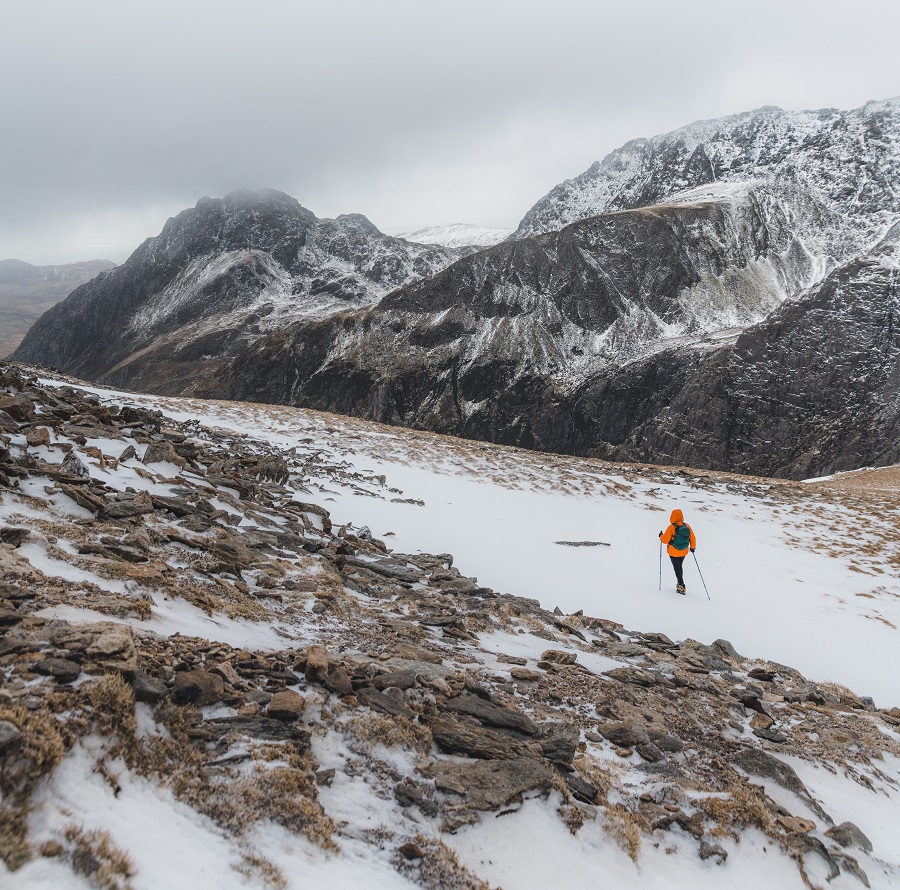
When winter sweeps in, blanketing our favourite trails with a soft quilt of snow, the allure of the wilderness doesn’t fade. If anything, the world becomes a silent, serene wonderland inviting us to step in and experience its transformed beauty. However, trekking during the winter months requires a bit more preparation. The elements can be both beautiful and harsh, and the rules for winter hiking are simple yet vital. Follow our guide on what to wear for winter hiking for comfort and safety on the trail.
Winter hiking kit list:
- Beanie / wooly hat
- Neck gaitor, buff or scarf
- Base layer top
- Insulating mid layer
- Outer layer shell jacket
- Gloves
- Day pack
- Water bottle / hydration system
- Hiking pants / baselayer
- Wool socks
- Waterproof boots / shoes
- Microspikes / crampons
The number one rule is Stay Dry!
Winter hiking presents a myriad of challenges, and moisture is one of the most deceptive ones. While one might initially think of snow and rain as the primary culprits, there are several sources of moisture to consider. Let’s dive into the elements and situations that could get you wet during your winter adventures in the UK.
Snow is the most obvious winter element. Falling snow can accumulate on your clothes, and while it may appear to sit on the surface, your body heat can cause it to melt and seep into your clothing. Additionally, trekking through deep snow can lead to snow entering your boots or clinging to your pants.
Rain during colder temperatures can be especially problematic because it can quickly saturate your clothing and reduce its insulation capability. Freezing rain, on the other hand, creates a layer of ice on top of everything it touches, which can melt with body heat and dampen your gear.
Sweat, as you exert energy, your body sweats to cool down. Without proper ventilation and moisture-wicking base layers, this sweat can accumulate, making your clothes wet from the inside.
Crossing water (depending on your trail). In winter, these water bodies can be deceptive. Ice might cover them, but it may not always be stable. A misstep could lead to wet feet or, worse, a full plunge into icy water.
Opt for layers to stay warm
Layering is the cornerstone of staying comfortable and safe during winter hikes. By wearing multiple layers, hikers can easily regulate their body temperature, ensuring they stay warm without overheating. Each layer serves a unique purpose: the base layer wicks away sweat, the middle layer insulates and retains body heat, and the outer layer shields against wind and precipitation.
As conditions change — be it due to increased physical exertion, fluctuating weather, or varied terrain — layers can be added or removed to maintain optimal body comfort. In essence, layering provides the flexibility to adapt to the unpredictable nature of winter, making it an indispensable strategy for outdoor enthusiasts.

What To Wear For Hiking In Winter, from top to bottom
Below we’ll guide you through the essential winter hiking attire, covering everything from the top of your head down to your toes, ensuring you’re well-prepared for the chilly outdoors.
1. Beanie or wooly hat
A good beanie is a hiker’s best friend in the colder months. The human body can lose a significant amount of heat through the head, and a beanie acts as a barrier, trapping that vital warmth. Choose a beanie made of materials like wool or synthetic fibers that offer both insulation and moisture-wicking properties. For those particularly bitter days or windy conditions, a beanie that covers the ears is a must-have.
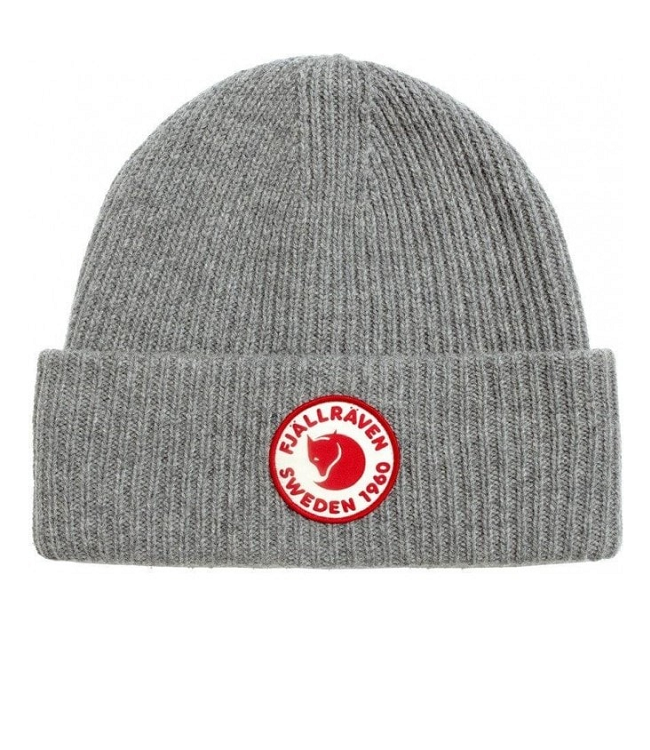
Fjallraven 1960 Logo Hat – £60
When it comes to combining style with functionality, the Fjällräven 1960 Logo Hat stands out. Drawing inspiration from the brand’s rich heritage and its foundation year, this hat is both a nod to history and a testament to modern design. Crafted from a blend of wool and acrylic, it provides the warmth and comfort essential for winter hikes, while effectively wicking away moisture to ensure you stay dry.
SealSkinz waterproof cold weather beanie – £23.99
The SealSkinz waterproof cold weather beanie’s waterproofing is unparalleled, offering top-tier protection against wet winter conditions. Beyond just keeping water out, its insulation properties guarantee warmth even in the coldest of environments. The meticulous blend of materials ensures comfort without compromising durability, meaning it’s built to last.
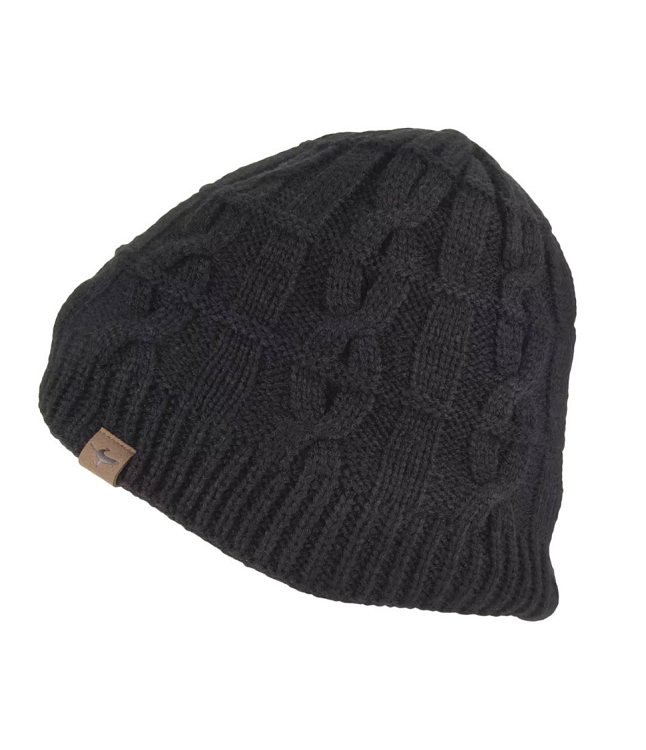
2. Neck Gaiter, Buff, or Scarf
Protecting the neck and face area is crucial, especially when confronting biting winds or falling snow. A neck gaiter or buff is versatile, offering protection while being lightweight and easy to pull up or down as conditions change. They can shield your neck, face, and even ears, and can be used as a headband, hat, or sun guard. Traditional scarves also work well to keep the neck warm, though they may be bulkier. If opting for a scarf, ensure it’s made of insulating material like wool, and be mindful of loose ends that could snag or get in the way during your hike.
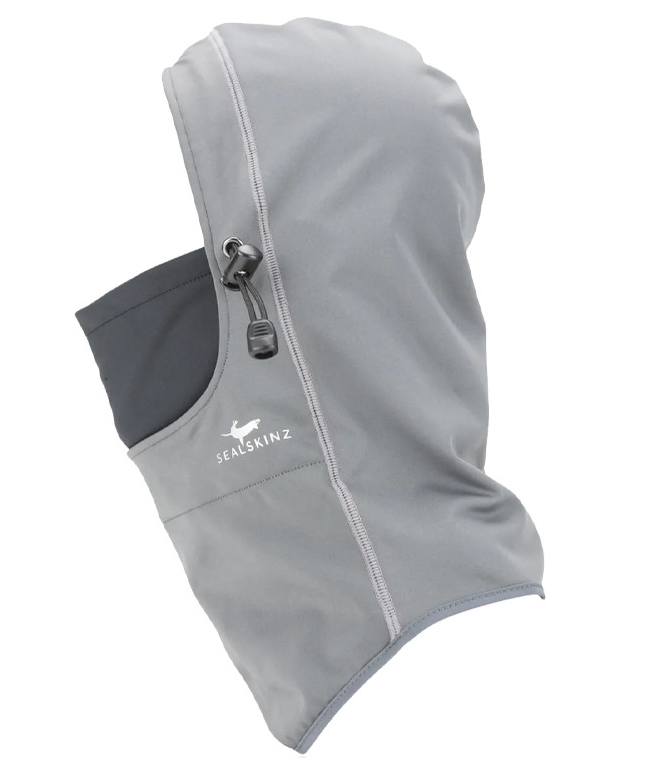
SealSkinz waterproof all weather gaitor – £22.39
Designed for all-weather conditions, this gaitor offers impeccable waterproofing, ensuring your lower legs remain dry and shielded from external moisture, be it rain, snow, or damp terrains. Beyond its water-resistant prowess, it’s constructed to be breathable, balancing protection with comfort, ensuring that while moisture stays out, perspiration can easily evaporate. This balance is crucial for extended hikes or outdoor activities, where comfort is paramount.
Merino wool tube scarf – £12.99
Harnessing the innate properties of Merino wool, this Buff scarf is inherently warm, moisture-wicking, and odor-resistant – making it a favorite among avid trekkers. Its versatility is unmatched; you can wear it as a neck warmer, a headband, a hat, or even a balaclava, adapting to the ever-changing demands of outdoor adventures. Its breathable nature ensures that while you stay warm, you’re not overwhelmed, maintaining an ideal temperature balance.
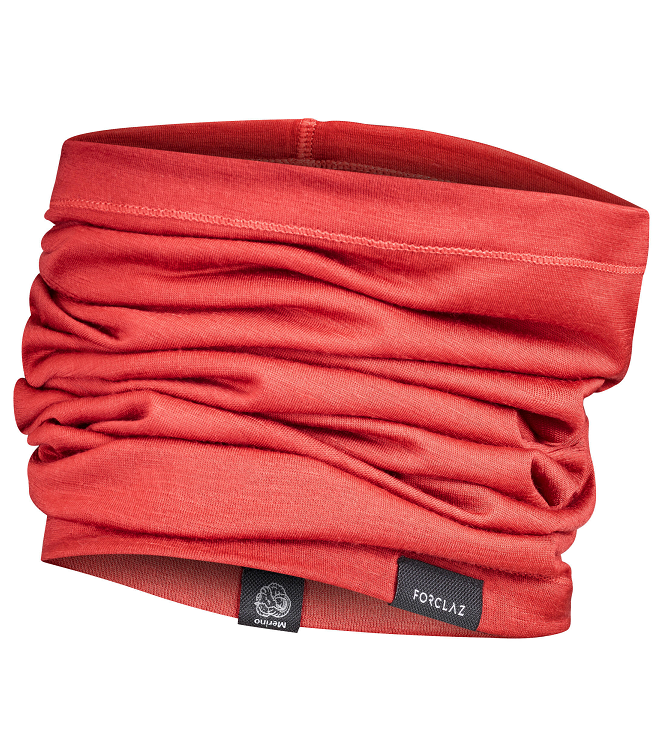
3. Base Layer Top
The base layer sits closest to the skin and serves the critical role of managing moisture. Materials such as merino wool or synthetic blends are ideal as they wick sweat away from the skin, preventing you from getting chilly. Avoid cotton, as it retains moisture and can leave you feeling cold and damp.
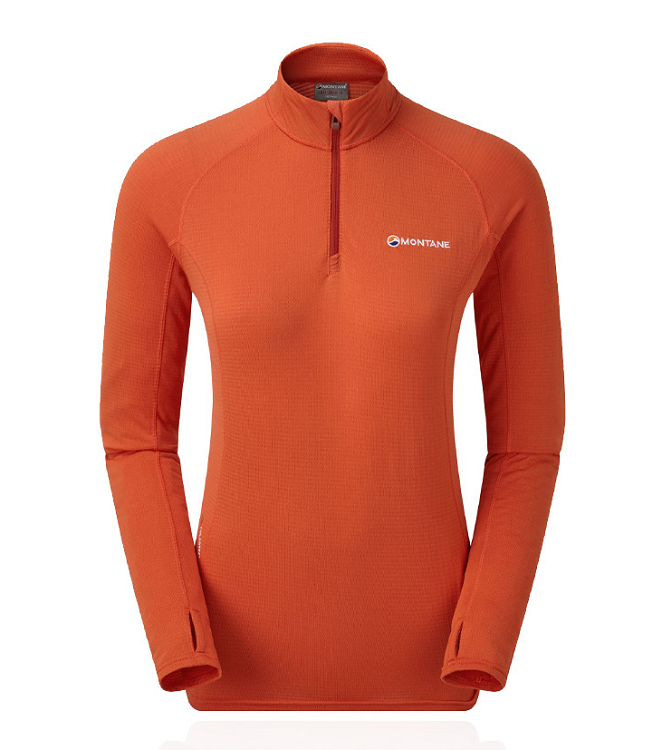
Montane Allez Micro Women’s Half Zip Top – £34.99
The Montane Allez Micro Women’s Half Zip Top is your secret weapon against the winter cold. It excels as a base layer, providing the crucial thermal insulation needed to keep your core warm and comfortable in freezing temperatures. Its versatile design allows you to adapt to changing weather conditions effortlessly.
Whether you’re tackling a snow-covered peak or exploring frosty forest trails, this top will be your trusted companion.
Helly Hansen HH Lifa Crew Baselayer Women’s Top – £27.99
The Helly Hansen HH Lifa Crew Baselayer Women’s Top is a game-changer for winter hiking. It’s the key to staying warm and comfortable in cold conditions, thanks to its advanced moisture-wicking and insulating capabilities. Whether you’re facing freezing temperatures, snow, or biting winds, this baselayer will keep you at your best.
As an essential component of your winter hiking gear, the HH Lifa Crew Baselayer sets the stage for a successful and enjoyable outdoor experience.
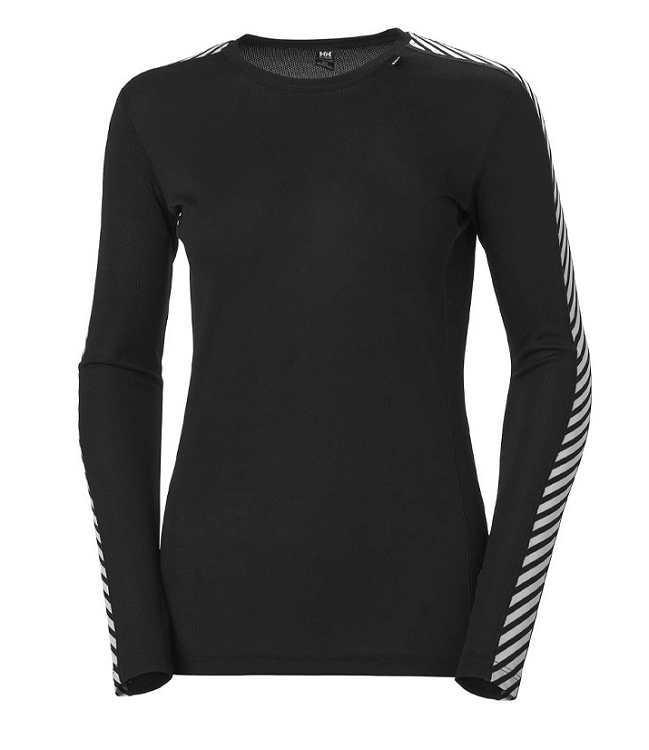
4. Insulating Mid-layer
This is where you trap the warmth. Fleece jackets, down jackets, or wool jumpers make excellent mid-layers. They provide the necessary insulation, ensuring your body’s generated heat is retained effectively. When considering down jackets, it’s crucial to be aware of the “fill power.” This number indicates the quality of the down; a higher fill power means the down will insulate better for its weight.
When choosing your insulating mid-layer, consider the conditions you’ll be hiking in and your activity level. If you expect wetter conditions or will be sweating a lot, a synthetic or hybrid jacket might be your best bet. If you’re aiming for a lightweight pack and maximum warmth, a high fill power down jacket would be ideal. Whatever you choose, ensure it complements your other layers, allowing for efficient moisture-wicking and protection against the elements.

Kathmandu Heli R Women’s Hooded Down Jacket – £155
Lightweight and easily packable, the Heli R is perfect for on-the-move adventurers. Filled with ethically sourced down, it offers superior insulation, ensuring consistent warmth in colder conditions. Its durable exterior is built to endure, while the streamlined fit combines style with function.
The inclusion of a protective hood, ample pockets for essentials, and adjustable features make it an essential choice for those seeking a reliable and fashionable mid-layer for their hiking escapades.
Columbia Women’s Westridge™ Packable Down Vest – £115
When embarking on winter hiking adventures, staying warm without sacrificing mobility is crucial, and the Columbia Women’s Westridge™ Packable Down Vest is your go-to solution. This versatile vest combines exceptional warmth with a lightweight, packable design, making it an essential addition to your winter hiking gear collection.
This packable down vest is insulated with high-quality down fill that provides superior warmth and comfort. This natural insulation efficiently traps body heat to keep you cozy in cold temperatures.
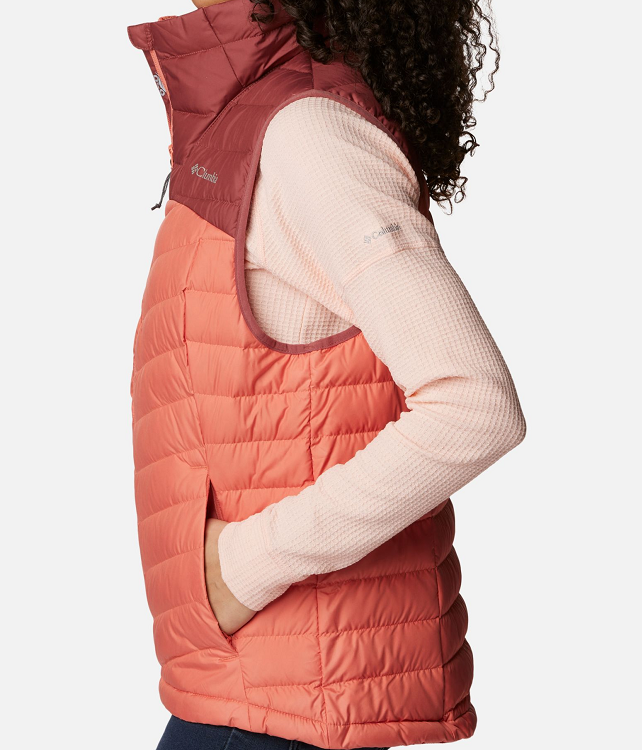
5. Outer Layer Shell Jacket
Protecting yourself from external elements like wind, snow, and rain is the role of the outer layer. Opt for a waterproof, windproof, and breathable jacket. Ventilation features, like underarm zips, can also be beneficial for longer hikes where you might need some temperature regulation.
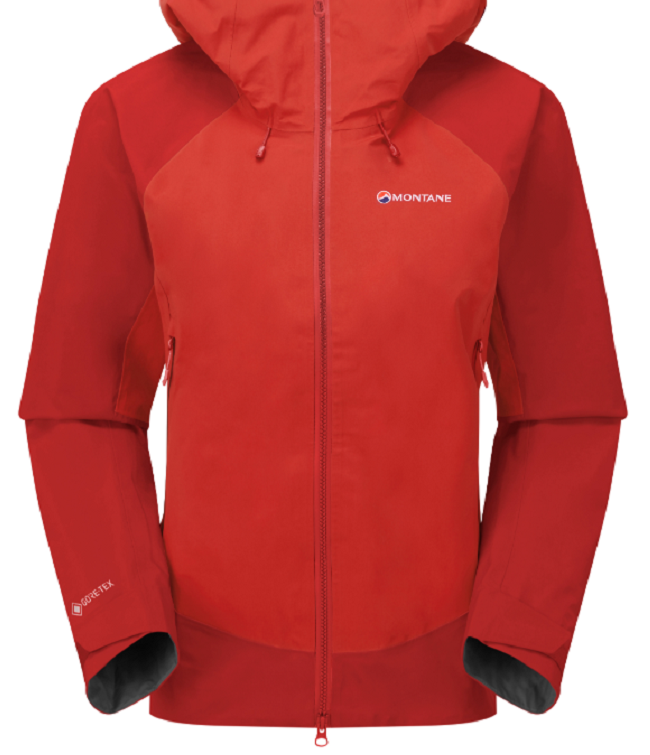
Montane Women’s Phase XPD Jacket – £425
The Montane Women’s Phase XPD Jacket ticks all the boxes for a quality outer layer. Specifically crafted for Alpine Climbing & Expeditions, it’s your ideal companion for the challenging conditions mountain environments present.
Featuring Gore-Tex® Pro’s most breathable technology, the jacket ensures not only weather protection but also an unparalleled level of breathability. It’s designed to work as hard as you do, especially during intense hikes and climbs.
Available from Trekitt £425.00 £500.00
Women’s Explorer’s Edge™ Waterproof Insulated Jacket – £200
The Women’s Explorer’s Edge™ Waterproof Insulated Jacket is a beacon of adventure-ready wear, further enhanced by its Omni-Heat™ technology. This innovative feature reflects body heat, amplifying warmth while ensuring optimal breathability. Coupled with its steadfast waterproof protection, the jacket promises dryness in the wettest conditions.
Beyond its protective layers, it remains lightweight and tailored for active endeavors, whether you’re ascending a rugged peak or navigating city streets. Built to endure, its durability is evident in every stitch, while its contemporary design ensures you’re always in vogue.
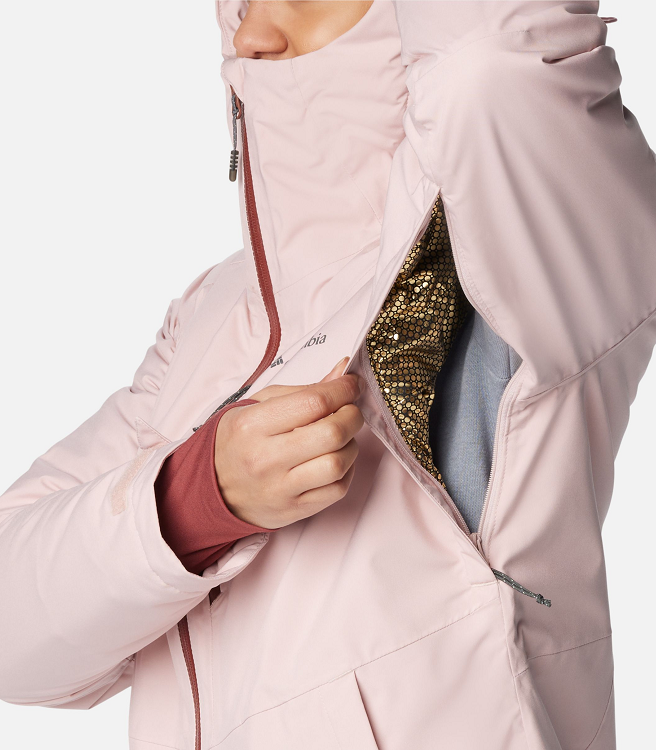
6. Gloves
Hands are particularly vulnerable to cold. Insulated, waterproof gloves are essential. For those with cold fingers, mittens can offer more warmth by keeping fingers together, sharing body heat.
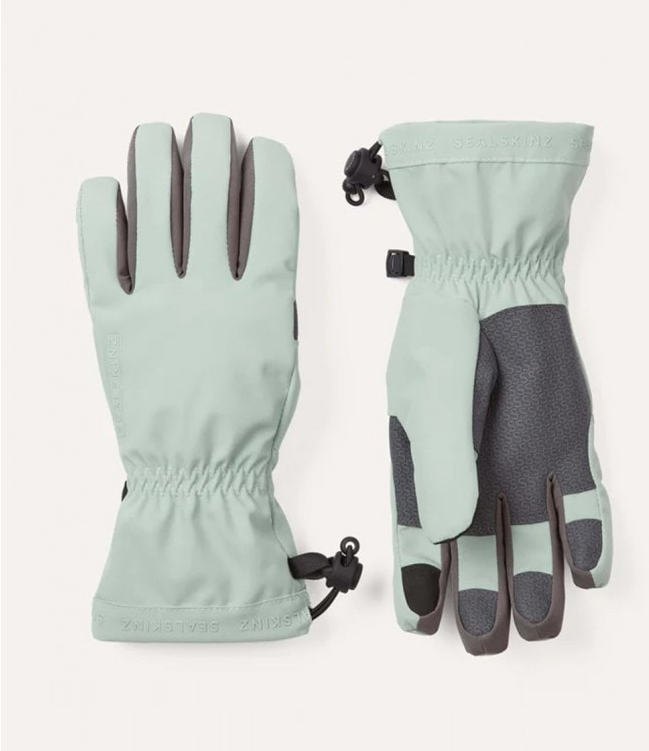
SealSkinz Drayton Waterproof Lightweight Gauntlet Glove – £45
Designed specifically for challenging environments, SealSkinz gloves promise total waterproofing, ensuring hands remain dry even amidst rain or snow. The lightweight gauntlet style provides extended coverage, further enhancing protection against the elements.
Durability is at its core, crafted to endure the demands of rigorous outdoor adventures. Yet, despite its robust protection, it maintains a comfortable and sleek fit. Whether facing drizzles or downpours, these gloves stand as a fortress for your hands, making them indispensable for winter hiking aficionados.
Bodylite V2 Thermal Gloves – £14
BODYLITE® V2 Thermal Gloves are a winter hiking essential for those who prioritize warmth without sacrificing dexterity. Crafted for optimal thermal efficiency, these gloves retain heat exceptionally while their lightweight design ensures you maintain full hand mobility. Built with durability in mind, they can withstand rigorous outdoor conditions. A must-have for hikers, these gloves ensure hands stay protected and agile, no matter the winter terrain.

7. Day pack
Embarking on a winter hike requires a little more preparation and gear than a summer jaunt. Thus, a reliable day pack becomes an indispensable companion. When choosing a day pack, you need to consider size and volume; Winter gear tends to be bulkier. For a day hike, a pack in the range of 20-30 liters should suffice. This provides enough room for your essentials, extra clothing layers, and snacks.
Another key feature is Waterproof or Water-resistant; snow and rain are always possibilities in winter. Opt for a pack with water-resistant material, and consider one with a rain cover for added protection.
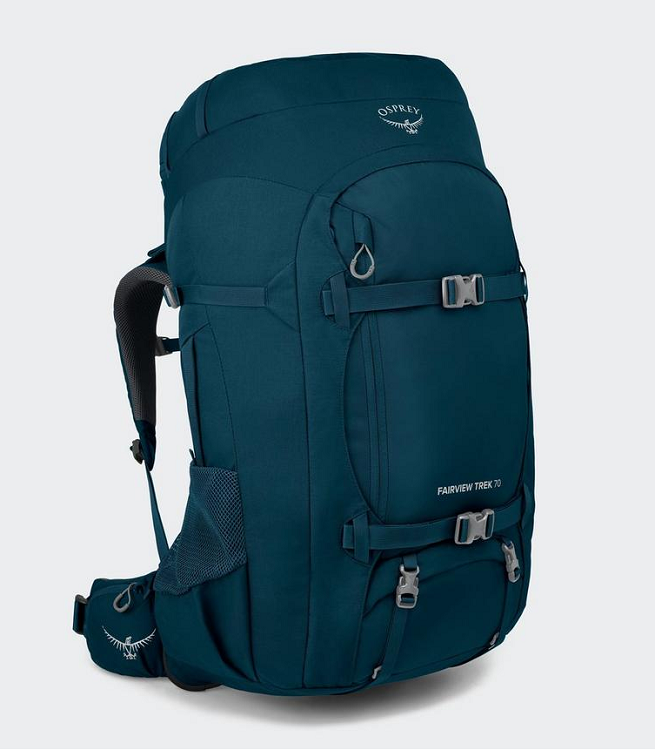
Osprey Women’s Fairview Trek 70 Backpack – £207
The Osprey Women’s Fairview Trek 70 Backpack is a paragon of travel and trekking excellence, specifically tailored to fit the female form. A testament to Osprey’s renowned craftsmanship, this backpack boasts a 70-liter capacity, ensuring ample space for all your adventure essentials. But it’s the ergonomic design that truly stands out.
The Fairview Trek 70 is built with a women-specific fit, guaranteeing optimal load distribution and unparalleled comfort during extended treks.
Lowe Alpine Airzone Trail ND 24L Women’s Daypack – £67
The Lowe Alpine Airzone Trail ND 24L Women’s Daypack is the epitome of comfort and functionality tailored for the adventurous woman. With a 24-liter capacity, it’s perfectly sized for day hikes, ensuring you carry all essentials without being weighed down.
The standout feature is its Airzone system, which promotes superior ventilation, ensuring your back remains cool and sweat-free, even during strenuous hikes. For those in pursuit of a lightweight, breathable, and stylish daypack, this is an unmatched choice.
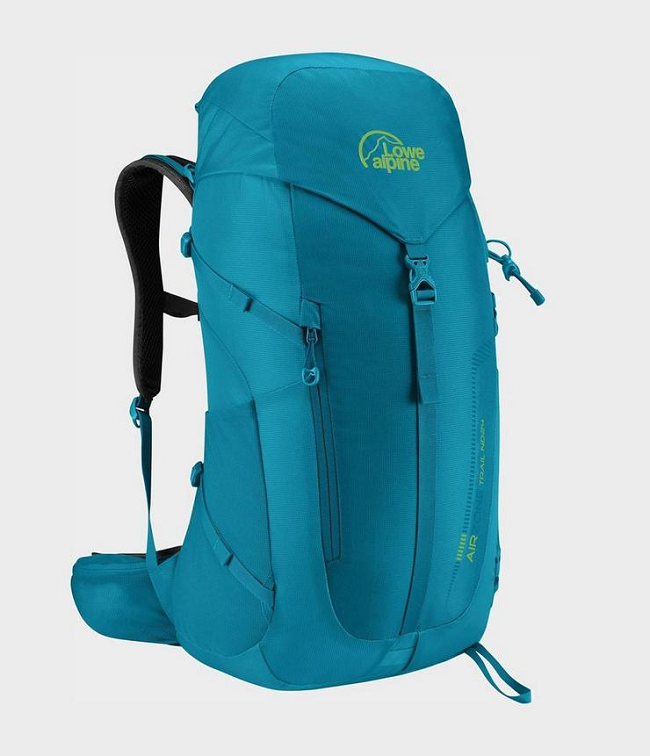
8. Water Bottle or Hydration System
Even in the icy embrace of winter, staying hydrated remains paramount. Cold air can be deceptively dry, and the physical exertion of hiking increases your fluid needs. Traditional water bottles should be made of durable material and preferably have an insulating sleeve to prevent freezing. Some hikers prefer hydration bladders for their convenience. If opting for a hydration system, ensure the hose is insulated to prevent water from freezing within it. Regardless of your choice, it’s wise to start with warm or room temperature fluids, as this delays freezing.
Top tip: store water bottles upside down; water freezes from the top down, so this method ensures the bottle’s opening remains ice-free for longer. Regular sips, even if you don’t feel thirsty, can help maintain energy levels and stave off dehydration’s negative effects
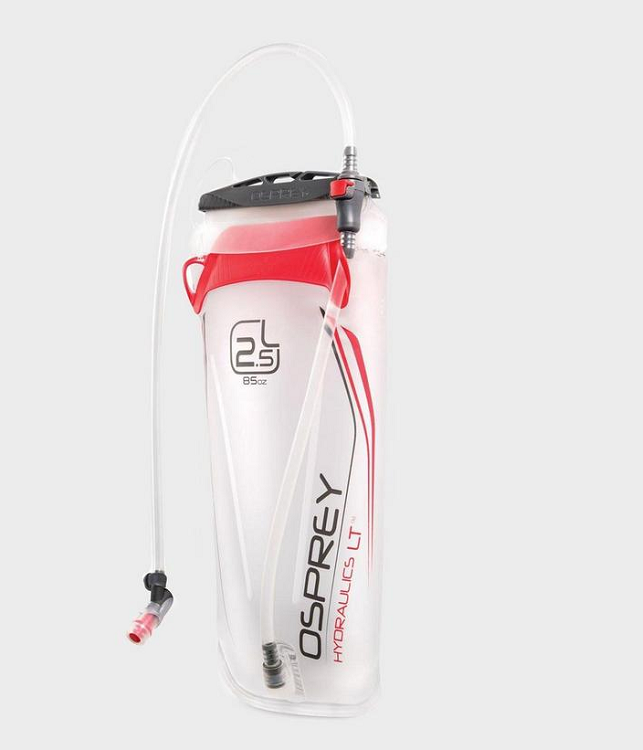
Osprey Hydraulics™ LT 2.5L Reservoir – £37
The Osprey Hydraulics™ LT 2.5L Reservoir is a hydration game-changer for outdoor enthusiasts. Designed to seamlessly integrate into a variety of packs, it ensures that you stay hydrated without breaking stride.
With a 2.5-liter capacity, it’s generous enough for longer treks, ensuring a constant supply of water. Its unique design features a slim profile, making it less obtrusive in the backpack and allowing for more space for other gear.
Lifestraw Go 2-Stage Water Bottle – £40
The LifeStraw Go 2-Stage Water Bottle is a must-have for adventurers who prioritize both hydration and health.
At its core, this bottle is built around the revolutionary LifeStraw technology, designed to filter out 99.9999% of bacteria and 99.9% of protozoa from freshwater sources. This means you can fill up from rivers, streams, or lakes during your hike and be confident in the safety of the water you’re consuming.
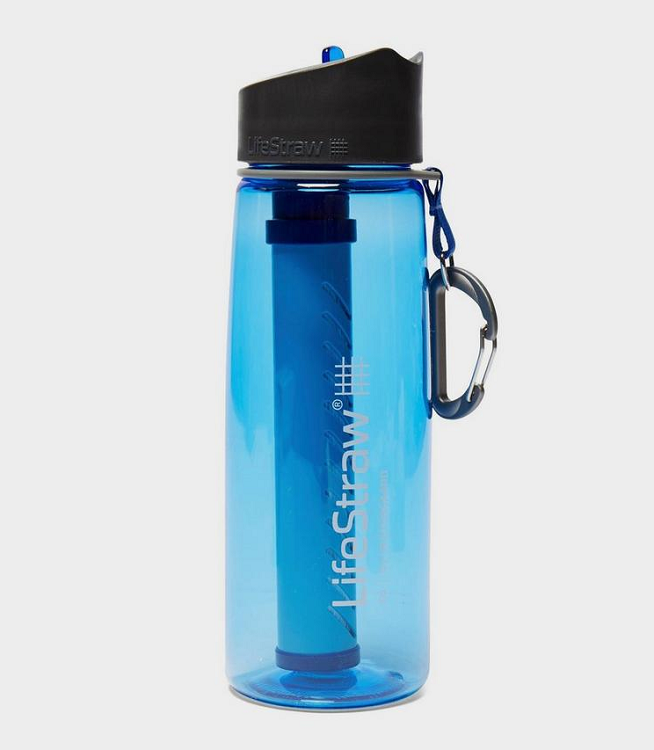
9. Hiking Pants and Baselayers
Start with moisture-wicking leggings or long underwear. Over this, wear insulated, waterproof pants to fend off the cold and any wet conditions. For deep snow hikes, gaiters are a great addition to keep snow out of your boots.
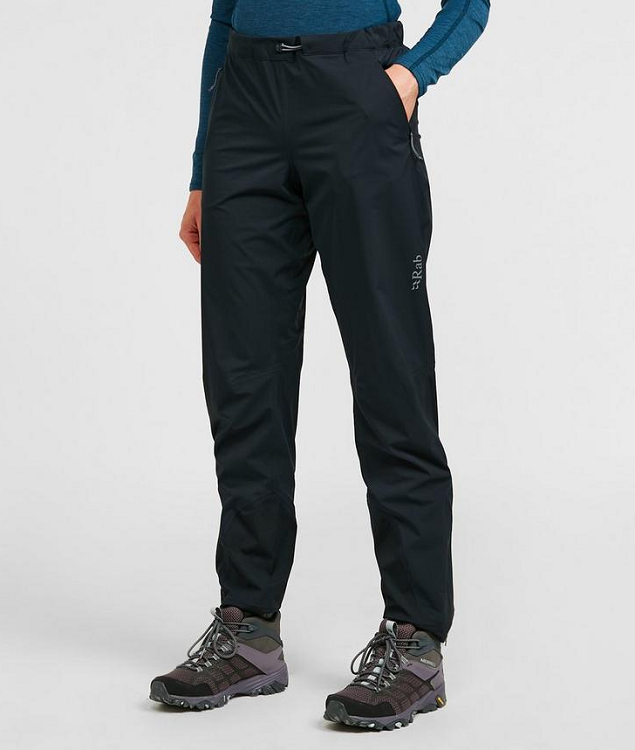
Rab women’s kinetic 2.0 waterproof pants – £139
Expertly blending the agility of a softshell with the resilience of a hardshell, the Rab Women’s Kinetic 2.0 waterproof pants promise unwavering waterproofing. But where they shine is in breathability, ensuring internal comfort while facing external downpours.
Lightweight and inherently stretchable, they allow unrestricted movement, perfect for active pursuits. With a sleek design that offers a snug fit and durability that Rab is renowned for, these pants are an outdoor essential, ensuring you remain dry, agile, regardless of the weather’s whims.
LOVALL Extreme Fleece Lined Leggings – £32
The LOVALL Extreme Fleece Lined Leggings are the quintessential blend of comfort and performance, specifically tailored for those who refuse to let the cold deter their adventures. Crafted with a soft fleece lining, these leggings promise to trap heat close to the skin, ensuring you remain warm even when winter presents its harshest face.
Their stretchable fabric ensures a snug fit, adapting to your body’s movements without any constraints, making them perfect for dynamic activities.
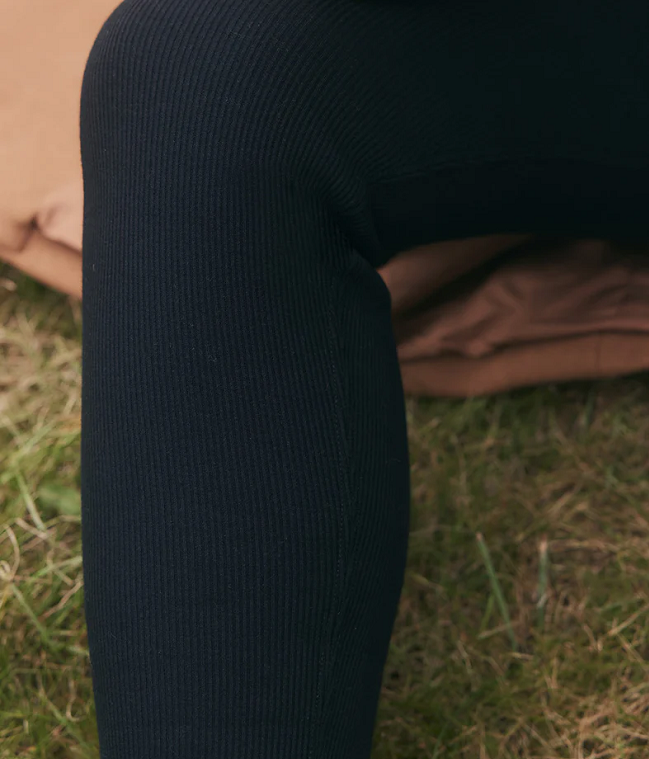
10. Wool Socks
Wool or synthetic blend socks are the best choices. They offer excellent insulation and wick away moisture. Always pack an extra pair, as wet feet can lead to discomfort or even frostbite.
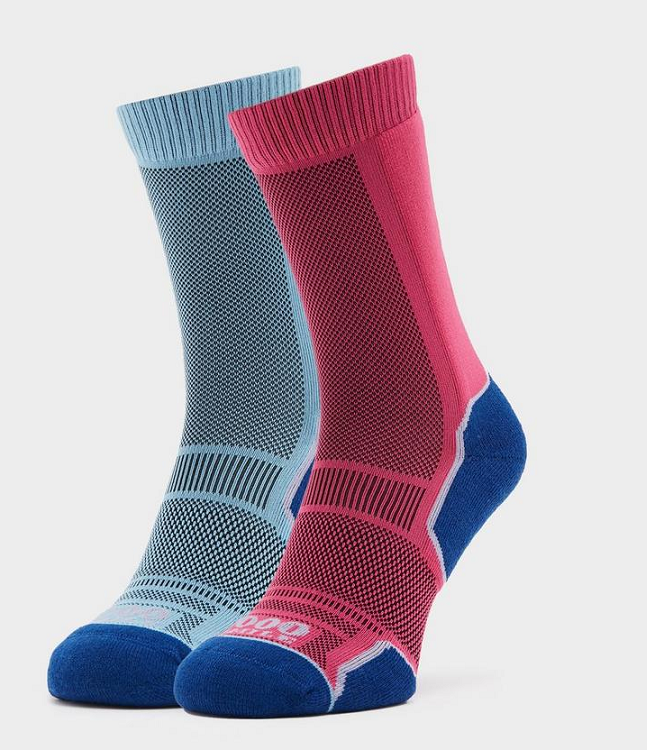
1000 MILE Women’s Trek Socks – £13.95
The 1000 MILE Women’s Trek Socks are the ultimate companions for feet that demand comfort and support on the trail. Designed specifically with the female hiker in mind, these socks offer a blend of durability and cushioning that ensures optimal protection against blisters and soreness. The magic of the 1000 MILE brand is embedded in its unique dual-layer construction. This design minimizes friction, a prime cause of blisters, by allowing the layers to move against each other rather than your skin.
Sealskinz Waterproof All Weather Mid Length Socks – £31.50
The Sealskinz Waterproof All Weather Mid Length Socks stand as a testament to advanced fabric technology, ensuring your feet remain dry and comfortable, no matter the conditions. A staple for outdoor enthusiasts, these socks are equipped with a hydrophilic membrane, rendering them 100% waterproof, while still maintaining impressive breathability. This means that while they repel external moisture like rain or wet terrain, they also allow internal moisture (like sweat) to escape, ensuring a dry environment for your feet.
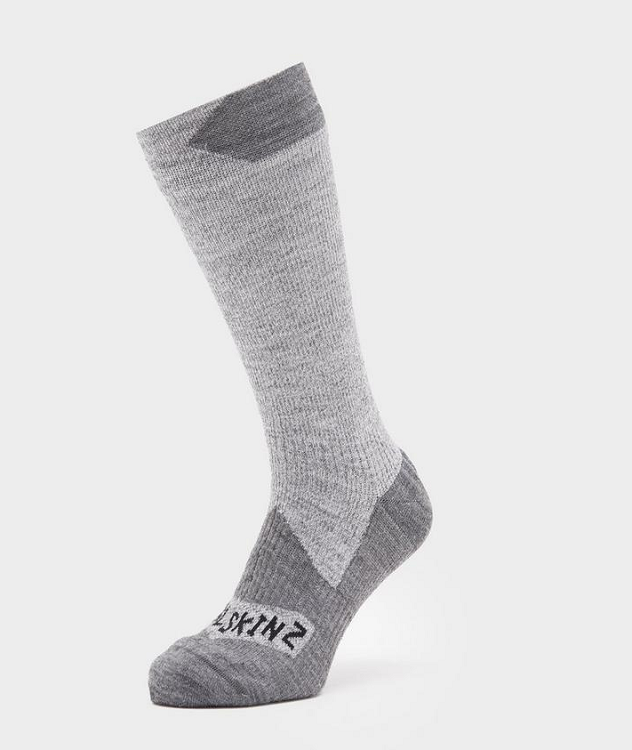
11. Winter Hiking Boots
Sturdy, waterproof hiking boots with good grip are essential for winter terrains. They should provide ankle support and be insulated for added warmth. Pair them with gaiters if trudging through deeper snow.
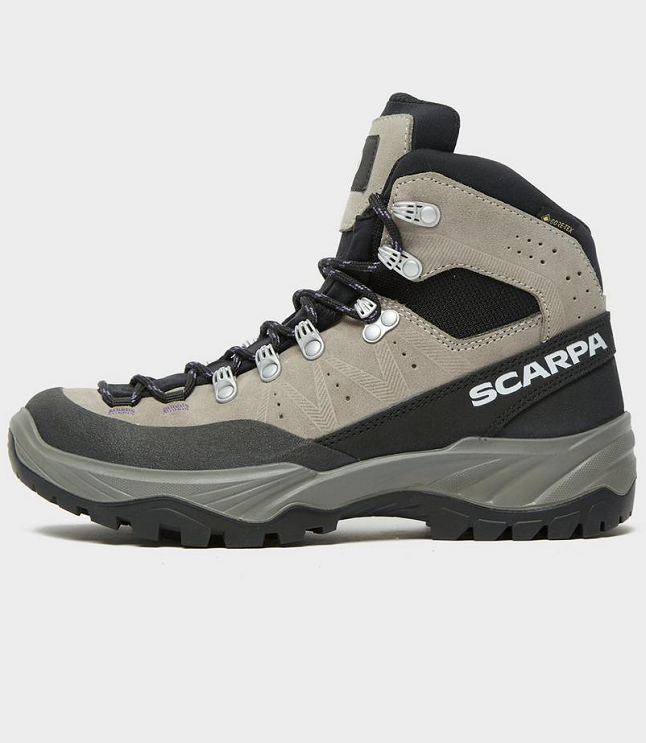
Scarpa Women’s Boreas GTX Mid Walking Boots – £175.50
The Scarpa Women’s Boreas GTX Mid Walking Boots are the embodiment of Scarpa’s legacy in delivering high-performance footwear, meticulously tailored for the female adventurer. Central to its design is the inclusion of the GTX, shorthand for the revered GORE-TEX® technology. This ensures the boots are not only fully waterproof, but they also maintain a high degree of breathability, making certain that your feet stay dry from both external elements and internal perspiration.
Salomon Women’s Onis Mid GORE-TEX® Hiking Boots – £99
The Salomon Women’s Onis Mid GORE-TEX® Hiking Boots are a shining example of where innovation meets precision in outdoor footwear. Designed specifically for the dynamic female hiker, these boots encapsulate the perfect balance of comfort, durability, and state-of-the-art technology. A standout feature is, without a doubt, the integration of GORE-TEX®. This ensures that the boots are impermeable to water, allowing adventurers to trudge through wet terrains without a second thought. Yet, even with this water-tight design, the boots remain highly breathable, ensuring feet remain dry and comfortable .
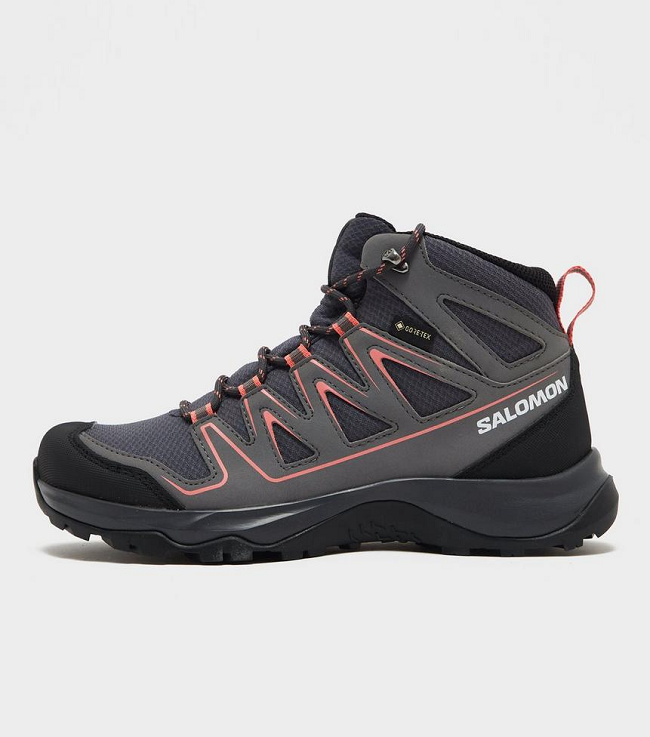
12. Winter trail shoes
Winter trail shoes are a must-have for the avid hiker trekking through cold, icy, or snowy terrains. Unlike regular hiking shoes, these are specifically designed to combat the unique challenges of winter landscapes. They come equipped with enhanced grip soles to prevent slipping on icy trails, and often feature waterproof or water-resistant materials to keep feet dry amidst snow and slush. Insulation is another crucial component, ensuring that your feet remain warm even when the temperature drops significantly. Lightweight yet robust, winter trail shoes offer a perfect blend of comfort, protection, and stability, ensuring every winter hike is both safe and enjoyable.
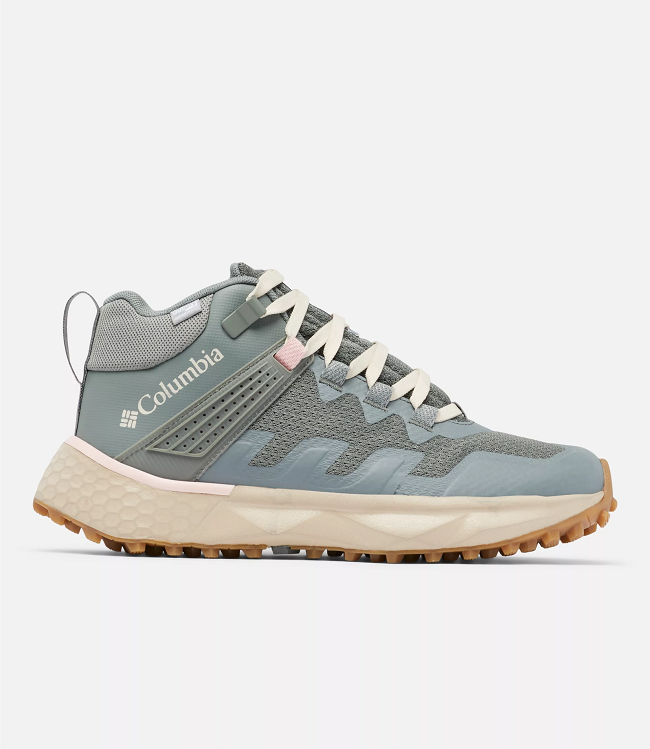
Columbia Women’s Facet™ 75 Mid Outdry™ Waterproof Hiking Shoe – £135
The Columbia Facet™ 75 Mid Outdry™ Waterproof Hiking Shoe represents a synthesis of style, comfort, and cutting-edge technology, tailored for the discerning female hiker.
At the heart of its design is the Outdry™ technology, which offers a fully waterproof barrier, ensuring that your feet remain dry even in the most challenging weather conditions. This waterproofing doesn’t come at the expense of breathability, ensuring that moisture from within can still escape, providing an optimum environment for your feet.
Merrell Women’s Siren 4 GORE-TEX® – £145
The Merrell Women’s Siren 4 GORE-TEX® is a testament to combining sleek design with trail-ready toughness. This shoe is explicitly crafted for women who tread both the beaten and unbeaten paths.
Central to its prowess is the integration of the GORE-TEX® technology, a renowned waterproof membrane that offers unparalleled protection against wet conditions while simultaneously allowing for breathability. This ensures that even in the wettest terrains, your feet remain dry and comfortable.
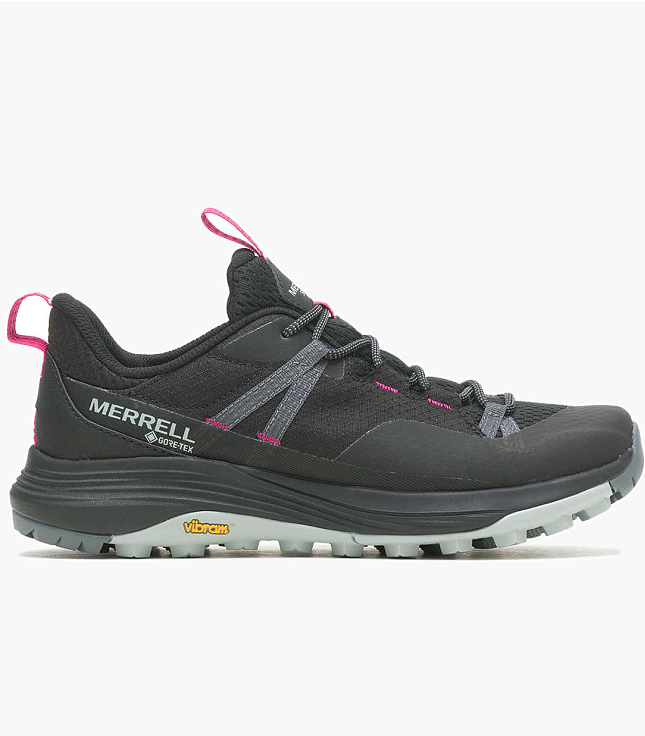
13. Microspikes or crampons
Microspikes are chains and spikes that easily slip over your hiking boots, suitable for icy paths and packed snow, providing increased traction without being overly aggressive. Crampons, on the other hand, are more robust, with longer spikes designed for icy or steep terrains and mountaineering adventures. They require a bit more experience to use effectively and safely. When choosing between the two, consider the conditions and difficulty of your hiking path. In many winter situations, microspikes will suffice and crampons require a specific type of boot. Below are two Microspikes we recommend for use in ice and thin snow only.
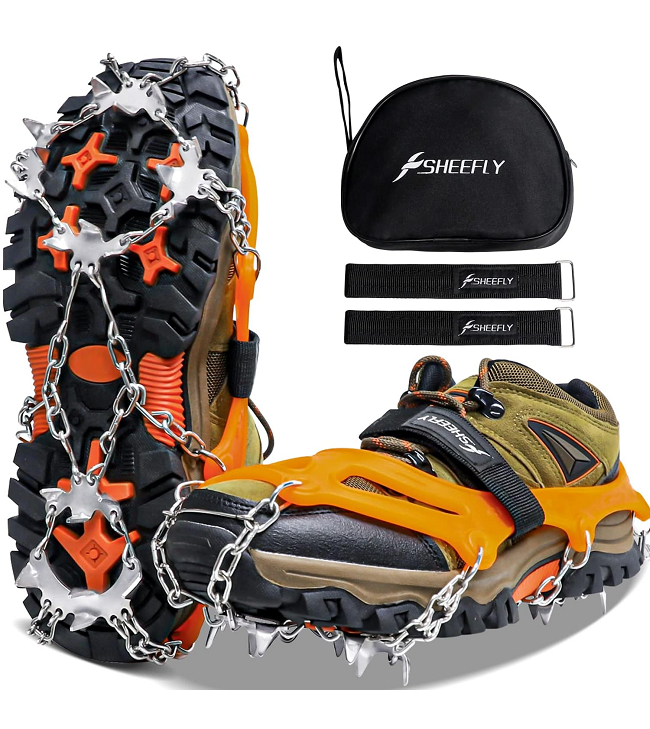
SHEEFLY Microspikes for ice and thin Snow – £16.99
SHEEFLY micro-spikes for hiking are an indispensable tool for adventurers looking to navigate icy and slippery terrains with confidence. Made with high-quality stainless steel, these spikes promise durability and resist rusting, ensuring they remain effective season after season. Each spike is designed to provide maximum traction, ensuring a firm grip even on the slickest surfaces. Easily attachable to a variety of footwear.
GRIVEL Explorer snow spikes – £30.56
The GRIVEL Explorer snow spikes stand as a testament to GRIVEL’s long-standing tradition of providing mountaineers and adventurers with top-tier equipment. For those who tread where snow and ice dominate the landscape, these spikes are more than a mere accessory; they’re a necessity.
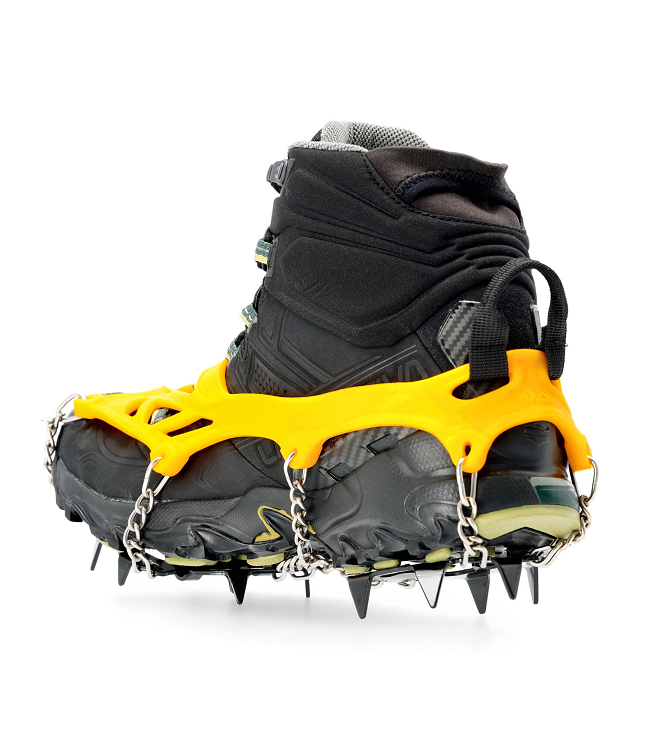
Safety First:
Before embarking on any outdoor adventure, it’s essential to research the specific route and anticipated weather conditions thoroughly. Conditions can vary greatly depending on the time of year, recent weather events, and other factors. The gear and recommendations provided in this article are general suggestions and may not be suitable for every situation or condition.
Always ensure that the gear you select aligns with the specifics of your journey. In addition, it’s advised to consult local guides, park rangers, or experienced hikers familiar with the area you plan to explore. Being well-prepared isn’t just about having the right gear; it’s about ensuring the gear you have is appropriate for the conditions you’ll face.
Remember, nature is unpredictable. Always prioritise safety, and when in doubt, seek expert advice or consider postponing your trek until conditions are more favorable.

From scaling mountain peaks to savouring exotic flavours, I’m a passionate explorer with an insatiable appetite for adventure and good food. As an Outdoor Adventure and Travel Editor, I’m constantly seeking new experiences that ignite my senses and broaden my horizons. Through my blog, I share captivating travel tales, mountain-tested advice, healthy food inspiration, and training tips to empower fellow adventurers on their own journeys of discovery.
Follow Sam’s adventures on Instagram @sams_adventures_x